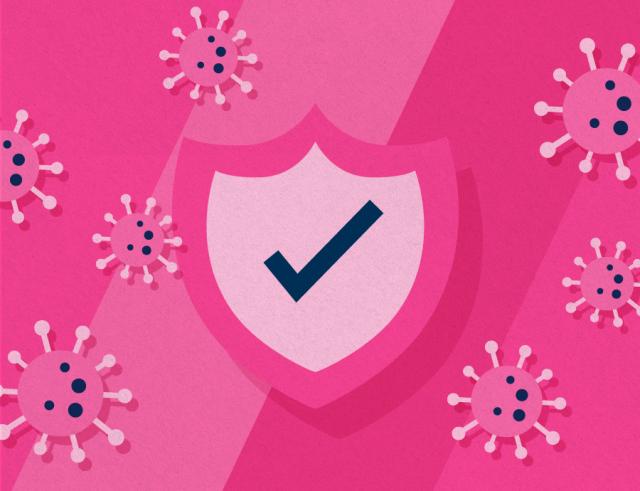See how vaccines work to set up your child for lifelong health.
One way to feel more confident about routine childhood vaccines is to better understand the science behind them. Learn more about what’s in them and how they work to protect your child against certain diseases.
How does your body’s immune system work?
The immune system is like a team protecting your body from harmful germs like bacteria, viruses, and fungi. When a harmful germ enters the body, certain immune system cells quickly raise the alarm and lock onto the outside of the germ. Then, a different immune cell rushes to the scene to kill the germ.source: 1
If this is the first time your immune system finds a particular harmful germ, the process can take time. It may take some time for the immune system to recognize the threat and build a team to destroy it. But the immune system has a great memory. So, the next time the germ enters the body, it can protect you much more quickly.source: 1

How do vaccines work?
Although the immune system is amazing, it is not perfect. It takes time to build the right team to attack a specific germ. In the time it takes to do that, the germ can create its own large team that the immune system cannot fight, which leads to us getting sick.
This is where vaccines come in. Vaccines are like teachers. They teach our immune system about harmful germs before there is a threat. They also teach our immune system to create antibodies and memory cells that fight those germs. When our immune system learns all of this from a vaccine, it is ready to jump into action.
As soon as a harmful germ (a bacteria or virus that someone has been vaccinated against) enters our body, a vaccine can help our immune system recognize it and fight it. Vaccines help protect us from the germs and help prevent us from getting sick. Even if we still get the disease, we probably won’t get very sick thanks to vaccines.source: 1 Vaccinated people are less likely to get hospitalized or die from the disease.
Getting started with vaccine science
In your journey to better understand vaccine science, you may wonder: Where do I start? There’s so much information out there, it can be overwhelming. We’re here to help you do your vaccine homework.
Types of vaccines
Vaccines help your immune system recognize either the whole virus or bacteria or a piece of it. Viruses and bacteria come in many different shapes, but they all have exterior “shells” and genetic material. These are what most vaccines target.source: 2
Vaccine ingredients
Each ingredient in a vaccine is included for a reason. Before the U.S. Food and Drug Administration (FDA) determines that a vaccine is safe and effective, the vaccine is thoroughly studied by FDA scientists and doctors.source: 3
- Active ingredient: Some vaccine ingredients are needed to build immunity. Vaccines have antigens, which are either a dead or weakened virus or bacteria, or a harmless piece of the virus or bacteria. Even though vaccines contain pieces of a virus or bacteria, they do not cause you to get the disease. Some vaccines also have adjuvants, which are substances that promote a strong immune response. The ingredients in a vaccine help your immune system respond to and build immunity against a specific disease.source: 4
- Stabilizers: Other ingredients help vaccines maintain their quality and help protect the vaccine from adverse conditions.source: 5,source: 6,source: 7 It’s a long road from the manufacturing plant to the doctor’s office or pharmacy. Stabilizers help make sure the vaccine works like it should once it gets to your child.
- Preservatives: Preservatives prevent the growth of bacteria or fungi that may get into the vaccine vial during its use. An example is when a multiple dose vial has repeated needles going into it.source: 5,source: 6,source: 7
- Adjuvants: An adjuvant is added to some vaccines to enhance the body's immune response. One example of an adjuvant is aluminum salts. Aluminum is found naturally in the world around us. As a vaccine ingredient, it has been studied and found to be safe for more than 70 years.source: 5,source: 8,source: 9
Learn more about why vaccines have so many ingredients and how we know they are safe.
Multiple doses and booster vaccines
Infants’ and children’s immune systems are used to being busy. Each day, their immune systems fight off as many as 6,000 different types of antigens, or germs, that they are exposed to as they play, eat, or touch objects.source: 10 Because children's immune systems are busy fighting these antigens, they are more than able to handle multiple doses of vaccines. Each vaccine in the childhood vaccination schedule has between one and 69 antigens.source: 11 That is a lot less than the 6,000 antigens they fight off each day!

What are antigens?
An antigen is anything that causes your immune system to react. They can be bacteria, viruses, or even pollen.source 1
When an antigen causes your immune system to react from nature or a vaccine, it responds to help protect your body from reacting in the future.
Multiple vaccines at the same time are safe.
Every day your child will encounter as many as 6,000 antigens just by being a kid.source 2
And that's okay because their immune system is designed to handle it. That's why receiving multiple vaccines at one time is safe.
Even if your child got 4 vaccines at once, it would be at most 276 antigens.source 3
Much less than what they encounter every day.
Understanding herd immunity
With many vaccines, when we vaccinate ourselves and our children, we protect others. Just like when other parents vaccinate themselves and their children, they protect our children. Many vaccines work best when everyone in a community who can be vaccinated is vaccinated. This protects the most vulnerable in our community like children who are undergoing cancer treatment or who have immune system problems.source: 12
Quiz: How well do you know the risks?
Question 1 of 5: Why do we still need to vaccinate for whooping cough?
Correct
Yes! All the answers are correct. Whooping cough can be very serious for babies.
Incorrect
Actually, all the answers are correct. Whooping cough can be very serious for babies.
Thanks to most kids getting whooping cough vaccines, cases of the disease have decreased more than 75%. And getting vaccinated while pregnant passes protection to the baby. This helps protect the baby before they’re old enough to get their own vaccine.
Question 2 of 5: If one person has measles, how contagious is it in people who are not immune?
Correct
Correct! Measles is one of the most contagious diseases in the world. If 1 person has it, 9 out of 10 people close to that person will also get measles if they aren't protected.
Incorrect
No, measles is one of the most contagious diseases in the world. If 1 person has it, 9 out of 10 people close to that person will also get measles if they aren't protected.
Measles can live in the air for up to 2 hours after an infected person leaves an area. It can be a very serious disease:
- 1 in 5 unvaccinated people who get measles will be hospitalized
- 1 in 20 unvaccinated children who get measles will get pneumonia
- Unvaccinated pregnant women who get measles may have a premature or low birth weight baby
Question 3 of 5: How many childhood deaths have routine vaccines prevented?
Correct
Very good!
Incorrect
No, vaccines have saved many more children!
Vaccines are expected to prevent more than 1 million deaths among children in the United States who were born between 1994 and 2023. That’s more than the entire population of Denver, Colorado.
Question 4 of 5: What diseases have vaccines wiped from the face of the earth?
Correct
Yes! Before a vaccine was used to eradicate smallpox, 3 out of 10 people who had it died.
Incorrect
Good try, but only smallpox has been wiped from the face of the earth. Before a vaccine was used to eradicate smallpox, 3 out of 10 people who had it died.
But we are also very close to eradicating polio. Polio paralyzed almost 21,000 people in the U.S. in 1952 alone. Polio is rare in the United States, but it still exists in a few countries in Asia and Africa. Remember, we still need to vaccinate until polio is gone everywhere, because viruses, just like people, travel.
Question 5 of 5: What are the risks of serious side effects happening after vaccination?
Correct
Yes! Generally, only 1–2 vaccine doses in 1 million will result in a severe allergic reaction.
Incorrect
No, the risk is much, much smaller. Generally, only 1–2 vaccine doses in 1 million will result in a severe allergic reaction.
To put that in perspective, you have a 1 in 15,300 chance of being struck by lightning in your lifetime and a 1 in 46,744 chance of dying from a hornet, wasp, or bee sting—both much more likely than having a severe allergic reaction from a vaccine.
It’s important to understand the true risk of something to make an informed decision.
Thanks for participating.
Want to brush up on your knowledge?
Browse this site to learn more.
You scored

Share the facts
Spreading the truth saves lives, so use our resources to help parents understand how vaccines work, why they’re safe, and how they help protect kids.
Vaccine safety
Vaccines go through extensive testing prior to being approved and rigorous monitoring after approval to ensure they are safe for your child.source: 13,source: 14,source: 15
Vaccine preventable diseases
Routine childhood vaccines help prevent the spread of illnesses that once killed or harmed many infants, children, and adults.source: 16,source: 17,source: 18
Vaccine schedule
Sticking to the vaccine schedule helps protect your child against more than a dozen diseases.source: 19,source: 20
Sources
- HHS: Vaccines Protect You
- CDC: Explaining How Vaccines Work
- FDA: Vaccines for Children - A Guide for Parents and Caregivers
- HHS: Vaccine Ingredients
- FDA: Common Ingredients in FDA-Approved Vaccines
- Children's Hospital of Philadelphia: Vaccine Ingredients
- CDC: Vaccine Basics
- American Academy of Pediatrics (AAP): Vaccine Ingredients: Frequently Asked Questions
- CDC: Adjuvants and Vaccines
- AAP: All About the Recommended Immunization Schedules
- CDC: Multiple Vaccines at Once
- HHS: Vaccines Protect Your Community
- CDC: How Vaccines are Developed and Approved for Use
- FDA: Vaccine Facts: Why You and your Family Need Vaccines
- FDA: Vaccine Development – 101
- AAP: 14 Diseases You Almost Forgot About Thanks to Vaccines
- HHS: Five Important Reasons to Vaccinate Your Child
- FDA: Vaccines Protect Children From Harmful Infectious Diseases
- CDC: Child and Adolescent Immunization Schedule by Age
- CDC: Reasons to Follow CDC’s Recommended Immunization Schedule
Disclaimer Policy: Links with this icon () mean that you are leaving the HHS website.
Disclaimer Policy: Links with this icon () mean that you are leaving the HHS website.
- The Department of Health and Human Services (HHS) cannot guarantee the accuracy of a non-federal website.
- Linking to a non-federal website does not mean that HHS or its employees endorse the sponsors, information, or products presented on the website. HHS links outside of itself to provide you with further information.
- You will be bound by the destination website's privacy policy and/or terms of service when you follow the link.
- HHS is not responsible for Section 508 compliance (accessibility) on private websites.
- For more information on HHS's web notification policies, see Website Disclaimers.










